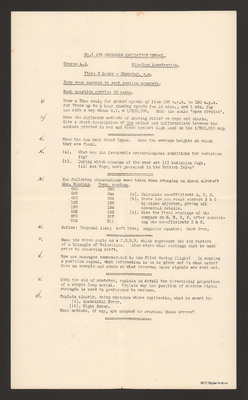No 1 air observers navigation school mid term examination
Title
No 1 air observers navigation school mid term examination
Description
Course A2, time allowed 3 hours. Contains 10 questions on general flying subjects, maps, weather and navigation
Creator
Coverage
Language
Format
One page printed document
Publisher
Rights
This content is available under a CC BY-NC 4.0 International license (Creative Commons Attribution-NonCommercial 4.0). It has been published ‘as is’ and may contain inaccuracies or culturally inappropriate references that do not necessarily reflect the official policy or position of the University of Lincoln or the International Bomber Command Centre. For more information, visit https://creativecommons.org/licenses/by-nc/4.0/ and https://ibccdigitalarchive.lincoln.ac.uk/omeka/legal.
Contributor
Identifier
MHudsonJD173116-151001-020002
Transcription
[underlined] No.1 AIR OBSERVER NAVIGATION SCHOOL.
Course A.2. Mid-Term Examination.
Time: 3 hours – Thursday, a.m.
Keep your answers to each section separate.
Each question carries 20 marks. [/underlined]
1. [symbol] Draw a Time scale for ground speeds of from 100 m.p.h. to 150 m.p.h. for Times up to 1/2 hour showing speeds for 10 mins., and 1 min. for use with a map whose R.F. = 1/500,000. Make the scale ‘open divided’.
2. [symbol] Name the different methods of showing relief on maps and charts. Give a short description of [underlined] one [/underlined] method and differentiate between the numbers printed in red and black against high land on the 1/500,000 map.
3. [symbol] Name the ten main cloud types. Give the average heights at which they are found.
4. [symbol] (a). What are the favourable meteorological conditions for radiation fog?
(b). During which seasons of the year are (i) radiation fogs, (ii) sea fogs, most prevalent in the British Isles?
5. [symbol] The following observations were taken when swinging an Anson aircraft
[underlined] Mag. Heading. Comp. reading. [/underlined]
[list of mag headings] [list of comp readings]
(a). Calculate co-efficients A, B, C.
(b). State how you would correct B & C by micro adjuster, giving all essential details.
(c). Give the final readings of the compass on N, E, S, W, after correcting the co-efficients B & C.
6. [symbol] Define: Isogonal line; soft iron; magnetic equator; hard iron.
7. [symbol] Name the three parts on a C.S.B.S. which represent the six factors of a Triangle of Velocities. Also state what settings must be made prior to observing drift.
8. [symbol] How are messages communicated to the Pilot during flight? In sending a position signal, what information is to be given and in what order? Give an example and state at what interval these signals are sent out.
9. [symbol] With the aid of sketches, explain in detail the directional properties of a simple loop aerial. Explain why the position of minimum signal strength is used in preference to maximum.
10. [symbol] Explain clearly, using sketches where applicable, what is meant by:
(i). Quadrantal Error,
(ii). Night Error.
What methods, if any, are adopted to overcome these errors?
Course A.2. Mid-Term Examination.
Time: 3 hours – Thursday, a.m.
Keep your answers to each section separate.
Each question carries 20 marks. [/underlined]
1. [symbol] Draw a Time scale for ground speeds of from 100 m.p.h. to 150 m.p.h. for Times up to 1/2 hour showing speeds for 10 mins., and 1 min. for use with a map whose R.F. = 1/500,000. Make the scale ‘open divided’.
2. [symbol] Name the different methods of showing relief on maps and charts. Give a short description of [underlined] one [/underlined] method and differentiate between the numbers printed in red and black against high land on the 1/500,000 map.
3. [symbol] Name the ten main cloud types. Give the average heights at which they are found.
4. [symbol] (a). What are the favourable meteorological conditions for radiation fog?
(b). During which seasons of the year are (i) radiation fogs, (ii) sea fogs, most prevalent in the British Isles?
5. [symbol] The following observations were taken when swinging an Anson aircraft
[underlined] Mag. Heading. Comp. reading. [/underlined]
[list of mag headings] [list of comp readings]
(a). Calculate co-efficients A, B, C.
(b). State how you would correct B & C by micro adjuster, giving all essential details.
(c). Give the final readings of the compass on N, E, S, W, after correcting the co-efficients B & C.
6. [symbol] Define: Isogonal line; soft iron; magnetic equator; hard iron.
7. [symbol] Name the three parts on a C.S.B.S. which represent the six factors of a Triangle of Velocities. Also state what settings must be made prior to observing drift.
8. [symbol] How are messages communicated to the Pilot during flight? In sending a position signal, what information is to be given and in what order? Give an example and state at what interval these signals are sent out.
9. [symbol] With the aid of sketches, explain in detail the directional properties of a simple loop aerial. Explain why the position of minimum signal strength is used in preference to maximum.
10. [symbol] Explain clearly, using sketches where applicable, what is meant by:
(i). Quadrantal Error,
(ii). Night Error.
What methods, if any, are adopted to overcome these errors?
Citation
Great Britain. Royal Air Force, “No 1 air observers navigation school mid term examination,” IBCC Digital Archive, accessed July 27, 2024, https://ibccdigitalarchive.lincoln.ac.uk/omeka/collections/document/10924.
Item Relations
This item has no relations.

